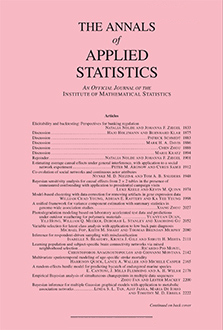Abstract
The processes influencing animal movement and resource selection are complex and varied. Past efforts to model behavioral changes over time used Bayesian statistical models with variable parameter space, such as reversible-jump Markov chain Monte Carlo approaches, which are computationally demanding and inaccessible to many practitioners. We present a continuous-time discrete-space (CTDS) model of animal movement that can be fit using standard generalized linear modeling (GLM) methods. This CTDS approach allows for the joint modeling of location-based as well as directional drivers of movement. Changing behavior over time is modeled using a varying-coefficient framework which maintains the computational simplicity of a GLM approach, and variable selection is accomplished using a group lasso penalty. We apply our approach to a study of two mountain lions (Puma concolor) in Colorado, USA.
Citation
Ephraim M. Hanks. Mevin B. Hooten. Mat W. Alldredge. "Continuous-time discrete-space models for animal movement." Ann. Appl. Stat. 9 (1) 145 - 165, March 2015. https://doi.org/10.1214/14-AOAS803
Information





